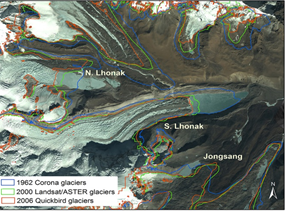

5th October 2023 (9 Topics)
Context
Recently, the Flash floods occurred in Sikkim after the South Lhonak Lake, a glacier lake located in the northwest region of the state, burst due to incessant rains.
What is Glacial Lake?
- Glacial lakes are large bodies of water that sit in front of, on top of, or beneath a melting glacier.
- As they grow larger, they become more dangerous because glacial lakes are mostly dammed by unstable ice or sediment composed of loose rock and debris.
What is Glacial Lake outburst?
- When the boundary around unstable glacial lake breaks, and huge amounts of water rush down the side of the mountains, which could cause flooding in the downstream areas.
- This is called glacial lake outburst floods or GLOF.
- Factors causing GLOF:
- GLOF can be triggered by several reasons, including earthquakes, extremely heavy rains and ice avalanches.
- These lakes are also often found in steep, mountainous regions, which means landslides or ice avalanches can sometimes fall directly into the lakes and displace the water, causing it to over-top the natural dam and flood downstream.
Features of GLOF:
- They involve sudden (and sometimes cyclic) releases of water.
- They tend to be rapid events, lasting hours to days.
- They result in large downstream river discharges (which often increase by an order of magnitude).
|
In 2013, one such event took place in Uttarakhand’s Kedarnath when the region witnessed flash floods along with a GLOF caused by the Chorabari Tal glacial lake. |
Why glacial lakes are now more susceptible to melting in Sikkim?
- With the rising global temperatures, glaciers in Sikkim Himalayan have been melting rapidly, giving rise to many glacier lakes and expanding the already existing ones in the region.
|
There are currently more than 300 glacial lakes in Sikkim Himalayan, according to the Sikkim State Disaster Management Authority.
|
Ways to reduce its impact:
- The NDMA released guidelines on how to deal with disasters caused by GLOFs. According to the guidelines, risk reduction begins with the identification and mapping of glacial lakes.
- Taking structural measures to avoid their breach and establishing robust mechanisms to save life and property in the event of a breach.
- Using Synthetic-Aperture Radar imagery to automatically detect changes in water bodies, including new lake formations, during the monsoon months.
- It also suggested that methods could be developed to permit remote monitoring of lakes from space.
- To manage lakes structurally, the NDMA recommends decreasing the volume of water with methods like controlled breaching, pumping or siphoning out water, and making a tunnel through the moraine barrier or under an ice dam.
|
South Lhonak Lake: the Location
|




